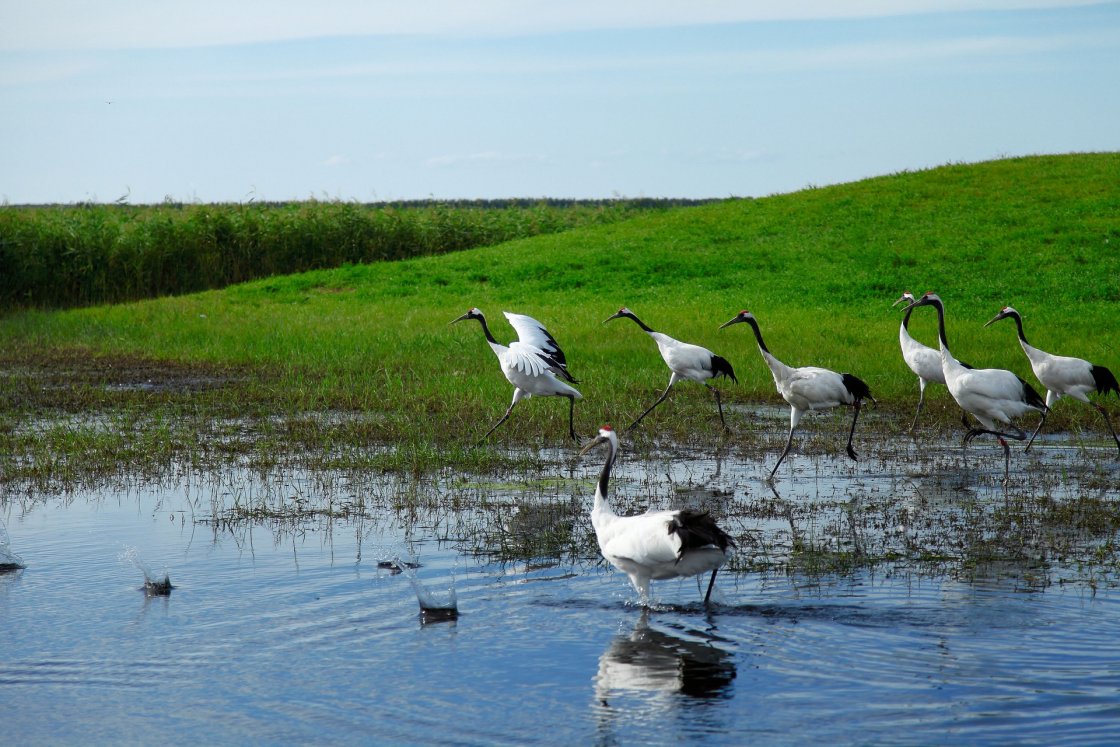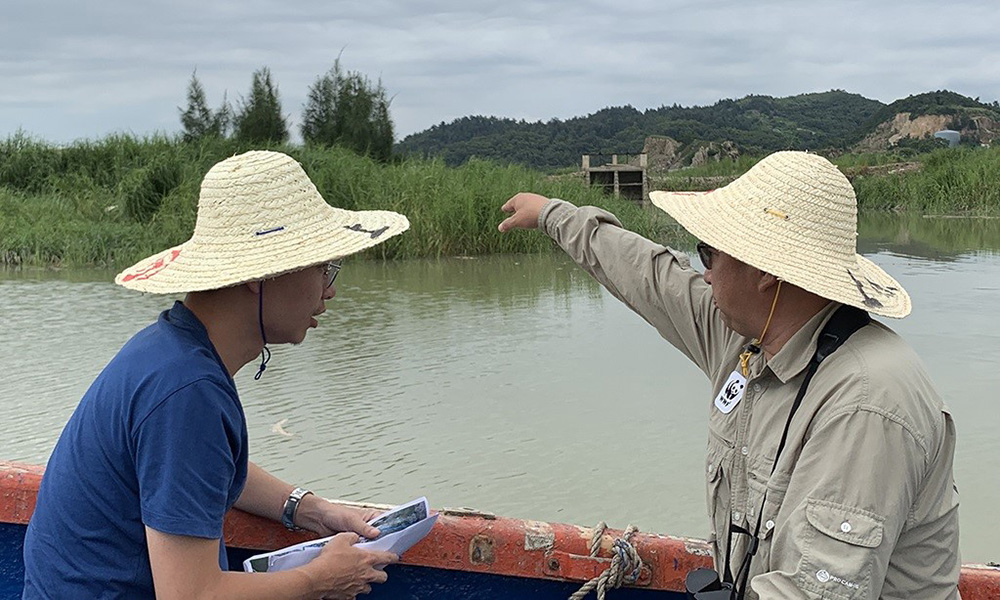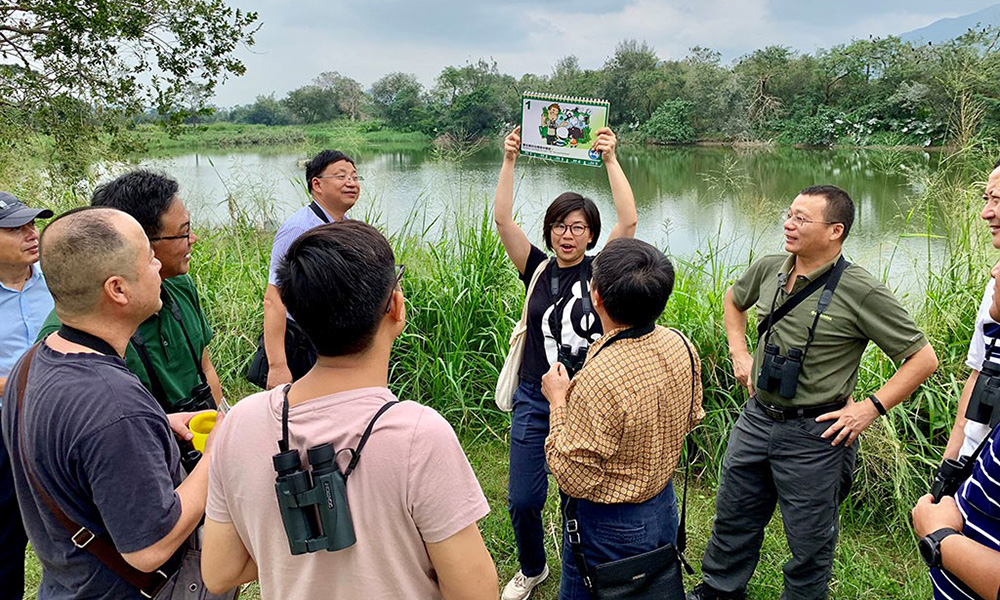You are here
The Asian Flyways Initiative

The WWF Asian Flyways Initiative brings together organizations and stakeholders with the aim of ensuring that the conservation of habitats critical for the survival of migratory birds is properly coordinated. The Initiative has enormous potential to raise awareness of the importance of conserving migratory birds and their habitats – complementary to World Migratory Bird Day, an international campaign organized by the Convention on Migratory Species (CMS), the Agreement on African-Eurasian Waterbirds (AEWA) and Environment for the Americas (EFTA).
Bird and nature lovers from all over the world flock to Asian wetlands to appreciate migratory bird species such as curlews, knots, sandpipers and ducks through activities such as bird watching.
Millions of birds travel distances as great as 13,000km from the Arctic to wintering grounds as far south as New Zealand, and they require ‘stepping-stone’ sites to rest and feed along on the way.
Flyways are systems of global importance for the conservation of bird species and their habitats. This was recognized by the Parties of the Convention on Migratory Species when they adopted a revised version of Resolution 12.11 on Flyways at the 13th Session of the Conference of the Parties in Gandhinagar in February 2020. The Resolution recognized that addressing flyways as important ecological networks is an important and necessary measure towards effective conservation and sustainable use of migratory birds and requires the cooperation of stakeholders at an international level.
CMS Resolution 12.11 also called for the implementation of the Programme of Work on Migratory Birds 2014-2023, which has set numerous goals and endorsed supporting activities designed to improve the status of migratory birds and their habitats worldwide.
Healthy wetlands along flyways are an important component of our ‘natural life support system’ protecting the coastline from flooding, thus mitigating the effects of climate change as well as providing vital habitat for migrating waterbirds. However, wetlands are being drained for conversion to urban, agricultural and industrial use. In addition to these man-made threats, coastal wetlands are vulnerable to sea level rise caused or exacerbated by climate change.
Flyways require a delicate balance to be struck between water management and bird conservation, as both people and wildlife need wetlands. The WWF Asian Flyways Initiative is intended to bring together organizations and stakeholders to ensure the coordinated conservation of the critical habitat birds need to survive along the flyway, in part through the maintenance of ecological corridors that sustain long-distance bird migrations. The Initiative also foresees that the wetlands involved will be managed for the benefit of both nature and people.

Besides carrying out cooperation projects, WWF staff also go around regionally to provide on-site advice on wetland management work. Photo – WWF Hong Kong.
The Vision of the WWF Asian Flyways Initiative is to ensure that ecologically connected networks of wetlands contribute to functional flyways by supporting stable migratory bird populations, conserve representative wetland biodiversity and ecological communities. The Initiative bears a human-focused approach, as well as ambitiously supporting the well-being of half the world’s population by providing ecosystem services and building climate resilience for the ecological and socio-economic sustainability of communities and countries.
The Goal of the Initiative is to ensure that by 2030 ecologically functional networks of wetlands are protected, restored as necessary, and effectively managed with community stewardship to stabilize or reverse the decline of migratory bird populations that use the flyways, and conserve wetland health for ecological and human well-being. The initiative envisions the following outcomes by 2030:
Outcome 1. Ecologically connected networks of wetlands effectively managed to ensure functionality of the Asian flyways.
Outcome 2. Migratory bird populations across the various flyways of Asia are stable or increasing.
Outcome 3. Millions of bird watchers are mobilized as citizen scientists to monitor bird populations and become advocates in support of wetland conservation.

WWF staff demonstrating the Lolo migration (migration game of Black-faced Spoonbill) in Mai Po Nature Reserve. Photo – WWF Hong Kong.
The WWF Asian Flyways Initiative team is working closely with the East Asian - Australasian Flyway Partnership (EAAFP), an informal and voluntary initiative aiming to protect migratory waterbirds across countries in the region. Adopted in the list of the World Summit on Sustainable Development, the EAAFP was launched on 6 November 2006 and aims to protect migratory waterbirds, their habitats and the livelihoods of people dependent upon them. The EAAFP currently brings together 37 Partners including 18 countries, 6 intergovernmental agencies, 11 international non-governmental organisations (NGOs), 1 international organization and 1 international private enterprise.
World Migratory Bird Day with WWF Hong Kong
To advance our understanding on waterbird migration in the EAAF, The Research Center for Eco-environmental Sciences, Chinese Academy of Sciences, Hong Kong Waterbird Ringing Group and WWF-Hong Kong have been working together to deploy satellite tracking devices on migratory waterbirds in the Mai Po Nature Reserve since 2017. The information collected throughout their annual migration cycle can contribute novel insights to the study of bird migration and ecosystem dynamics, and provide guidelines to land management and conservation efforts which are particularly essential due to the global anthropogenic changes in land use and ecosystem deterioration, especially in East Asia. On the World Migratory Bird Day this year, WWF-Hong Kong will share interesting findings about the tracked birds. Stay tuned to know about the species that have been tracked, where they have been to and their intriguing behaviours.
The Asian Flyways
There are five flyways covering Asia: The Asian-East African, the Central Asian, the East Asian-Australasian, the West Pacific and the African-Eurasian.
The Asian–East African Flyway starts from the northern breeding grounds of waterbirds in Siberia and leads across Asia to East Africa. Little has been published about birds using this flyway.
The Central Asian Flyway starts from the northern breeding grounds of water birds in Siberia and leads across Asia to the Indian subcontinent. Little has been published about birds using this flyway.
The East Asian–Australasian Flyway starts at the Taymyr Peninsula in Russia and Alaska and extends southwards to southeastern Asia, Australia and New Zealand. This flyway overlaps with the West Pacific Flyway. About 60 species of shorebird use this route.
The West Pacific Flyway links New Zealand and the east coast of Australia, through the central Pacific Ocean and the east coast of northern Asia, including Japan and the Korean Peninsula, ending up in eastern Siberia, including the Chukchi and Kamchatka Peninsulas, and Alaska. This flyway overlaps with the East Asian–Australasian Flyway.
The African-Eurasian Flyway covers the whole of Europe, Africa and the Middle East as well as the Canadian Archipelago and parts of Central Asia. It is covered by three instruments concluded under CMS – the Agreement on the Conservation of African-Eurasian Migratory Waterbirds (AEWA) and the Memorandum of Understanding on the Conservation of Migratory Birds of Prey in Africa and Eurasia (Raptors MOU), and the African-Eurasian Migratory Landbirds Action Plan (AEMLAP).
